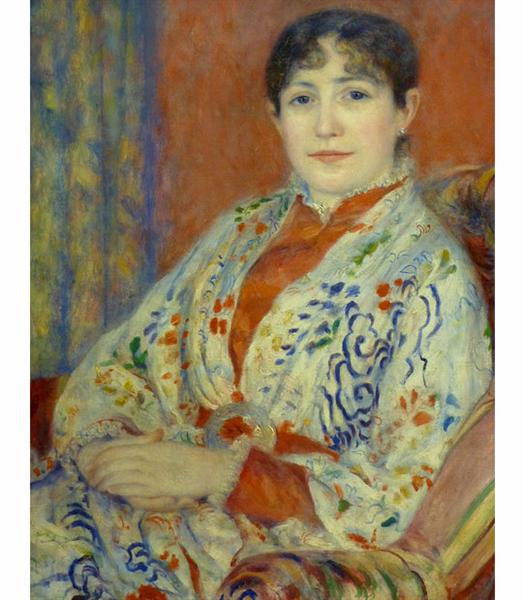Opis
Portret zatytułowany „Madame Hériot”, namalowany przez Pierre-Auguste Renoir w 1882 r., Jest dziełem, który obejmuje opanowanie impresjonizmu poprzez reprezentację postaci żeńskiej i użycie żywej palety kolorów. Jako jeden z głównych wykładników ruchu, Renoir nie tylko uchwycił zewnętrzną esencję swoich modeli, ale także starał się przekazać intymne i emocjonalne wrażenia w swoich portretach.
W „Madame Hériot” postać kobiety wyróżnia się na pierwszym planie, pokazując celowe podejście do jej twarzy i jej spokojny wyraz. Renoir wykorzystuje zrównoważoną kompozycję, w której figura jest prezentowana pod nieco trzech kwadratowych kątem, co przynosi dynamizm obrazowi. Kobieta, brązowe włosy, które delikatnie składają się, nosi czarną sukienkę ozdobioną białą kokardką, która subtelnie kontrastuje z jej ciepłym i jasnym odcieniem skóry. To użycie trzeźwego, ale eleganckiego kostiumu pozwala, aby cechy twarzy i ekspresji Madame Hériot jest prawdziwym centrum uwagi, w narracji wizualnej, która tańczy między elegancją a ciepłem.
Paleta kolorów używana do odnowienia w tej pracy jest świadectwem jej zdolności do zabawy światłem i kolorem. Ciepłe tony dominują na twarzy modelu, podczas gdy najciemniejsze tony sukienki dodają głębokości, która otacza jasność ich skóry. Poprzez płynne i luźne pociągnięcia pędzla Renoir osiąga wrażenie miękkości i witalności, tworząc atmosferę, która odzwierciedla oczekiwaną osobowość swojego modelu. Ten styl jest reprezentatywny dla ImpataniMo, w którym podejście odsuwa się od szczegółów fotograficznych, aby przyjąć bardziej poetyckie i emocjonalne wrażenie.
Tło farby jest równie znaczące. Często fundusze na prace odnowieniowe wskazują na środowisko, które, choć nie jest dokładnie zdefiniowane, sugerują zadumę lub szerszy świat poza indywidualnym portretem. W „Madame Hériot” niebieskie i zielone tony uzupełniają główną postać, sugerując związek z naturą i życiem na świeżym powietrzu, które było tak charakterystyczne dla pracy Renoira. To naturalistyczne podejście jest nie tylko samym tłem, ale staje się integralną częścią narracji portretu.
Renoir, znany z podejścia do reprezentacji kobiet, wykorzystuje tę pracę do odkrywania kobiecości i intymności. Wyrażenie modelu, który emanuje spokój i zaufanie, może być postrzegane jako odzwierciedlenie postrzegania, które odnowiła kobietę w swoim czasie, postać obejmującą zarówno łaskę, jak i siłę. Madame Hériot, której tożsamość jest nieodłącznie związana z tym obrazem, jest pamiętana nie tylko jako przedmiot artystyczny, ale jako ikona tamtych czasów i symbol estetyki z końca XIX wieku.
Zatem „Madame Hériot” to nie tylko portret kobiety z XIX wieku, ale reprezentuje ideały i poszukiwania impresjonizmu: uchwycenie efemerycznego piękna codziennego życia. Praca Renoira stanowi dialog między widzem a przedstawioną postacią, spotkaniem, które nadal rezonuje. Rozważając tę pracę, nie można uniknąć poczucia wchłaniania nie tylko techniką i kolorem, ale także nieuniknioną ludzkości, która emanuje, świadectwo wyjątkowej wizji odnowy i jej zdolności do wieczorowania momentów ponadczasowego piękna.
KUADROS ©, słynna farba na ścianie.
Ręcznie wykonane obrazy olejne, z jakością profesjonalnych artystów i charakterystyczną pieczęcią KUADROS ©.
Usługa reprodukcji zdjęć z gwarancją satysfakcji. Jeśli nie jesteś w pełni zadowolony z repliki twojego obrazu, zwrócimy twoje pieniądze w 100%.

